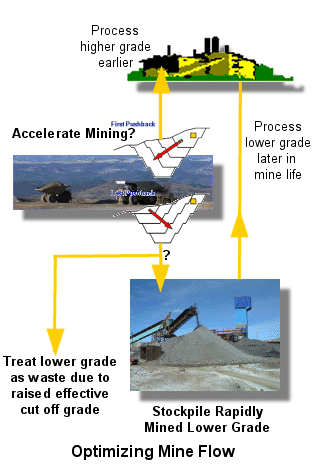What is Mine Flow Optimizer?
In Studio NPVS, the Scheduler produces a schedule that is practical, meets production targets and maximizes the use of processing capability.
Note: Mine Flow Optimization is fully integrated in Studio NPVS+ meaning a separate MFO optimization isn't required. As such, this module does not appear in Studio NPVS+.
The Mine Flow Optimizer (MFO) can be used to determine whether the NPV of the mine plan can be further increased by accelerating the rate of mining to extract and process higher grade ore sooner.
What triggers this situation? There are various limiting factors associated with scheduling mining operations, not least of which is the capacity to process the mined ore. Processing plants have a known (and often, fixed) capacity that may limit the amount of throughput in a given time, say, per year. Remember that one of the golden rules of any mining operation is to return the highest value (realize the greatest NPV) in as short a time as possible. In general, this means it is desirable to mine the highest grade of ore before lower grades, providing this is physically possible (and practical). In this situation, a processing plant will be working more effectively (generating a higher volume/grade of product) if it is being 'fed' with high grade ore at the start of the mine life.

The NPV will increase if this higher grade ore is processed instead of ore scheduled for processing by the Scheduler. MFO includes in its optimisation the consideration of whether the ore being replaced by mining faster should be stockpiled or treated as waste, and if it is to be stockpiled, when it should be processed.
Cut-off Grade Optimization
It should be noted that increasing the rate of mining to release higher grade ore sooner effectively increases the ore cut off grade during the periods for which the mining rate is increased. Studio NPVS’s method for optimizing the mining rate, or cut off grade has the following advantages over traditional methods of cut off grade optimization:
Because the input into MFO is an OES there is no averaging of grades over a year and there is much greater certainty that the increase in NPV can actually be achieved.
It is common for cut off grade optimization to be calculated using grade tonnage curves or grade classes for sections of the mine as inputs. For example, a set of grade classes that defines the tonnages of ore within a set of grade ranges may be calculated for each pushback. Cut off grade calculations then determine the amount of material to be taken from each pushback each year to maximize value. The problem with this approach is that the physicality of where the material lies within each pushback is lost and value calculations can vary considerably depending on whether ore can actually be mined at the beginning or end of a year. In the worst case the theoretical NPV produced using grade classes cannot be reproduced in a physical mine plan. Both the Scheduler and MFO within Studio NPVS produce precise physical plans and do not suffer from these disadvantages.
The output of MFO is a refined Schedule OES containing updated time periods.
Note: Studio NPVS also supports a Material Allocation Optimization module. See What is Material Allocation Optimizer?. MAO is not available, or required, in Studio NPVS+.
MFO will perform complete stockpile evaluations at all iterations. This can be useful, for example, when high grade material is stockpiled, and processing plants are not available or have reduced capacity in the initial periods.

